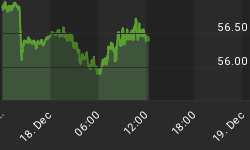Apples are, according to many nutritionists, good for us. However, one has to be sure to choose the right ones as AAPL has demonstrated in recent months. AAPL, despite the Street's claim in would be working its way toward $1,000 by now, has fallen hard from the tree. Now badly bruised, investors are suffering from a collapse of more than 25% from the high. Investors would have been far better off, as the following chart portrays, down on the farm, perhaps in real apples.

Portrayed in the above chart is the Agri-Food Price Index which attempts to measure the movement of Agri-Commodity prices over time. That index is just shy of the high. As is the case with all markets, each component is not acting as the index has been. Group rotation is an ongoing process in all markets. At the present time, the relative strength is gradually shifting from the major grains, corn, wheat, and soybeans, to other sectors. Prices for chickens recently touched a 90-week high as did those for the USDA beef index.
Within the Agri-Commodity sector, animal proteins continue to be severely under priced. In that sector, comprised of pork, beef, and chicken, prices need to rise by 50% or more to reestablish equilibrium with grain prices. Those closest to the cattle business, for example, are optimistic, which may not be good for your food budget. One recently wrote, "The year 2013 will be monumental for the commercial cattle industry with record-high prices for most (if not all) classes and the fruition of tight supplies due to compound years of drought and herd sell off. Anticipation will be on high throughout the new year; first to see how quickly feeder offerings dwindle, later for hopes of spring grass, and finally for a bountiful corn crop to resolve feed cost issues."(USDA National Feeder & Stocker Cattle Summary, 21 December)
For most of us, raising a few head of cattle in the back yard is impractical, and probably illegal. Chickens are smaller, but many neighbors would still be upset. Nearly all the popularly offered investment vehicles are based on commodity indices so poorly constructed as to make them near dangerous to an investor's health.(We would not use any of them.) That leaves investors with Agri-Equities as perhaps the best means of participating in the positive trend in Agri-Commodities.
In the chart is our index of Agri-Equity prices for first tier Agri-Companies. As is readily apparent, the index is attempting to close out 2012 at, or close to, a new high. Obviously, this index has no AAPLs in it.

Results in that chart are no simple happenstance. The fundamentals, portrayed somewhat in the first chart, are real. China is real, and unless those billion people suddenly disappear they will continue to eat. The Chinese economy is indeed going to be the largest economy, and its bill for imported food will only grow. Unlike the U.S. which is hobbled by the Obama Fiscal Cliff and the EU mired in socialist policies, China's economy will continue to expand. Chinese incomes and the money spent on imported food will continue to grow. Make learning about Agri-Food and Agri-Equities one's goal for 2013, and maybe your family be able to eat apples in the future.
AGRI-FOOD THOUGHTS is from Ned W. Schmidt,CFA,CEBS, publisher of The Agri-Food Value View, a monthly exploration of the Agri-Food grand cycle being created by China, India, and Agri-Energy. To contract Ned or to learn more, use this link: www.agrifoodvalueview.com















